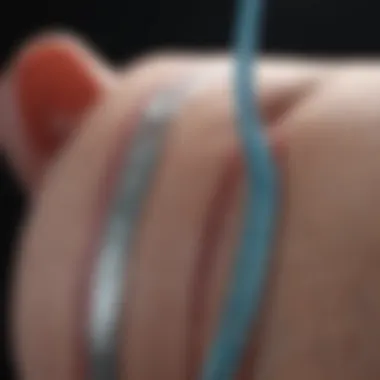Stents for Enlarged Prostate: An Emerging Solution


Intro
Benign prostatic hyperplasia (BPH) represents a significant health challenge, particularly for aging men. The condition leads to a range of disruptive urinary symptoms due to the enlargement of the prostate gland and often requires intervention. While traditional treatments such as medications and surgical options have been widely used, stent technology emerges as a promising alternative. Understanding the role of stents in managing BPH can provide insights into their potential benefits and complications, making this a valuable topic for both medical professionals and patients.
This article investigates the multifaceted aspects of stent technology, including the underlying biological mechanisms of BPH, the anatomical features of the prostate, and how stents function to alleviate symptoms. It aims to describe various stenting techniques, their effectiveness, and any associated risks. Moreover, it emphasizes patient selection criteria and highlights advancements in stent design that enhance their usability and effectiveness. The narrative concludes by exploring future directions of research in this area, making it an essential read for those interested in the latest solutions for BPH.
Prelims to Enlarged Prostate
Understanding the enlarged prostate is essential for grasping the implications it carries for male health. This condition, medically recognized as benign prostatic hyperplasia (BPH), profoundly influences the quality of life for many older men. The prostate gland's growth leads to various urinary symptoms, which can severely impact daily activities. By exploring the causes, epidemiology, and associated risk factors, we can emphasize the need for effective treatment solutions such as stenting.
Understanding Benign Prostatic Hyperplasia
Benign prostatic hyperplasia is a common condition as men age. Physically, it involves the enlargement of the prostate gland, which surrounds the urethra. This growth often leads to compression of the urethra, resulting in urinary problems. Some typical symptoms of BPH include frequent urination, difficulty starting or stopping urination, and a weak urine stream. These symptoms can lead to frustration and discomfort for those affected, prompting the exploration of various treatment options. BPH may not be life-threatening, but its influence on health and well-being should not be underestimated.
Epidemiology and Risk Factors
The prevalence of benign prostatic hyperplasia increases significantly with age. Studies indicate that around 50% of men in their 50s and up to 90% of men over 80 years of age experience some degree of prostate enlargement. Aside from age, several risk factors contribute to the development of BPH. These may include:
- Family history: Genetics play a role in susceptibility to prostate enlargement.
- Hormonal changes: Alterations in hormone levels due to aging can impact prostate growth.
- Lifestyle factors: Obesity, diet, and sedentary lifestyle may also elevate BPH risk.
Understanding these factors can assist in early detection and effective management strategies, ultimately leading to better patient outcomes.
Recognizing the epidemiology and risk factors associated with BPH sets the foundation for further discussions about treatment options. The exploration of stenting emerges as a relevant solution for managing the symptoms of BPH, hence leading us to delve deeper into this innovative approach.
Anatomy of the Prostate Gland
Understanding the anatomy of the prostate gland is essential when discussing treatments for benign prostatic hyperplasia (BPH). The prostate is a small, walnut-sized gland located below the bladder and surrounding the urethra. It plays a crucial role in male reproductive health. Its primary function is to produce a fluid that nourishes and transports sperm, contributing to semen during ejaculation.
The prostate comprises several zones, each with distinct cellular structures and functions. The peripheral zone, for example, contains most of the glandular tissue and is the most common site for prostate cancer. In contrast, the transition zone is where the growth associated with BPH predominantly occurs. Understanding these distinctions can help in tailoring treatment plans that involve stents and other interventions.
Prostate Structure and Function
The prostate gland is made up of glandular and stromal tissues. The glandular component produces prostatic secretions, which are alkaline to support the viability of sperm in the acidic environment of the female reproductive tract. The stromal tissue consists of smooth muscle and connective tissue, providing structural integrity and aiding in ejaculation through its contraction.
A well-functioning prostate contributes significantly to male fertility. It protects the urethra and contributes to urinary function, an aspect crucial when considering conditions like BPH, where urinary flow is affected.
Impact of Growth on Urinary Function
As the prostate enlarges, particularly in cases of BPH, it can exert pressure on the urethra. This condition leads to various urinary symptoms, often severely impacting quality of life. Patients might experience frequent urination, difficulty in starting urination, or a weak urine stream.
The growth of the prostate may lead to the following complications:
- Obstructed Urinary Flow: As the prostate expands, it obstructs the pathway for urine, causing discomfort and urinary retention.
- Increased Urgency: Patients often feel a sudden need to urinate, which can disrupt daily activities.
- Incomplete Emptying: Many individuals struggle with the sensation of not fully emptying the bladder.
The assessment of these symptoms is critical before considering stenting as a viable intervention. Understanding the anatomy helps medical professionals choose the most appropriate solutions tailored to a patient’s specific condition.
It's crucial that the treatment strategies consider the anatomical complexities of the prostate to effectively alleviate symptoms and enhance patient outcomes.
Current Treatment Modalities


The management of benign prostatic hyperplasia (BPH) has evolved significantly over the years, both in terms of pharmacological advancements and surgical techniques. Understanding the current treatment modalities is crucial for clinicians and patients alike, as it sets the stage for evaluating the potential role of stents in alleviating urinary symptoms associated with BPH. This section outlines the main options available today, emphasizing their specific elements, benefits, and considerations.
Pharmacological Management
Pharmacological treatment serves as the first line of management for many individuals diagnosed with BPH. The primary goal of medication is to relieve symptoms and improve quality of life without the need for invasive procedures.
- Alpha-Blockers: These are commonly prescribed to relax the muscles in the prostate and bladder neck. Medications such as tamsulosin and alfuzosin help decrease urinary obstruction, leading to improved urinary flow. The side effects can include dizziness, fatigue, and retrograde ejaculation.
- 5-Alpha-Reductase Inhibitors: Drugs like finasteride and dutasteride work by blocking the conversion of testosterone to dihydrotestosterone, a hormone linked to prostate growth. This class of medication may take several months to show effectiveness but can reduce prostate size over time. Side effects may include sexual dysfunction and breast tenderness.
- Combination Therapy: In certain cases, combining a 5-alpha-reductase inhibitor with an alpha-blocker can yield better outcomes, especially for patients with moderate to severe symptoms.
Pharmacological management has its limitations, particularly in patients with larger prostates or severe symptoms. Patients may also experience challenges with adherence to long-term medication regimens, leading to continued research into alternative treatments, including stenting.
Surgical Interventions
When pharmacological treatments fail or when symptoms severely impact a patient's daily life, surgical interventions may become necessary. Various surgical options provide effective relief from urinary symptoms.
- Transurethral Resection of the Prostate (TURP): This is an established surgical method that involves removing part of the prostate gland to relieve pressure on the urethra. It is effective and has a good track record for patient satisfaction. However, it carries risks, such as bleeding and the possibility of erectile dysfunction.
- Laser Therapy: Laser techniques such as Holmium Laser Enucleation of the Prostate (HoLEP) offer a minimally invasive alternative to TURP. They use focused light to remove or vaporize prostate tissue. This method is associated with less blood loss but requires skilled personnel.
- Open Prostatectomy: In cases of significantly enlarged prostates, an open surgery may be indicated. This involves a larger incision and typically requires a longer recovery period but can be effective for reducing prostate size.
- Emerging Surgical Techniques: Newer procedures like prostate artery embolization and robotic-assisted surgeries are being explored. These techniques may offer additional benefits like shorter recovery times but are still undergoing evaluation.
Overall, surgical interventions can drastically improve urinary flow and quality of life. However, they come with their own risks and complications, leading to a search for less invasive alternatives like prostatic stents.
"With the right treatment plan, the quality of life for patients with BPH can significantly enhance, but understanding the pros and cons of each option remains essential."
In summary, both pharmacological and surgical modalities represent critical strategies in managing BPH. Each approach has its benefits and drawbacks, which highlights the necessity for ongoing advancements in treatment options including stents as a possible solution.
Role of Stents in Treatment
Stents are becoming an essential part of managing benign prostatic hyperplasia (BPH). Their role is not just as a temporary fix but as a long-term solution for many patients. This section will explore the various aspects of stenting that merit attention. Understanding their function and application can significantly influence treatment outcomes and patient satisfaction.
Mechanism of Action
Stents function primarily by providing structural support within the prostatic urethra. When inserted, they expand and hold open the passageway, counteracting the pressure exerted by an enlarged prostate. This action allows for a more regular flow of urine, reducing the symptoms associated with BPH such as urgency, frequency, and nocturia. The materials used in stents are designed to be biocompatible and often feature coatings that help minimize irritation and reduce adherence of tissue. Through these mechanisms, stents can improve the overall urinary function of patients, enhancing quality of life.
Types of Stents Used
There are several types of stents suitable for treating BPH. The most common include:
- Urethral Stents: These are implanted directly into the urethra. They can be self-expanding or balloon-expandable, and their design varies to accommodate different anatomical variations.
- Prostatic Stents: Specifically designed for the prostate, these stents can help maintain continuous urethral patency.
- Temporary Stents: These may be used in specific clinical scenarios where temporary relief is needed, such as after surgical procedures.
- Permanent Stents: Selected for long-term management of urinary obstruction due to BPH. Each type has distinct characteristics and is chosen based on individual patient needs and the clinical scenario.
Indications for Stenting
Stenting is particularly indicated for patients who experience moderate to severe urinary symptoms and have not found relief through pharmacological therapies. The following criteria are typically used to determine if stenting is appropriate:
- Severity of Symptoms: Patients with significant discomfort or impairment in daily life due to urinary issues are prime candidates.
- Prostate Size: Larger prostates often benefit more from stenting, as traditional treatments may be less effective.
- Previous Treatment Failures: For those who have not responded well to medications or have sought relief from other surgical options, stenting offers a viable alternative.
- Overall Health Considerations: Patients who may be at risk for complications from traditional surgery due to other health issues might benefit from the less invasive stenting option.
In summary, stents represent a pivotal advancement in the management of enlarged prostate. As a treatment option, they offer unique benefits that other modalities may not provide. Understanding how they work, the types available, and who is eligible can greatly influence patient care and outcomes.
Technique of Stenting for Enlarged Prostate
The technique of stenting for managing enlarged prostate, also known as benign prostatic hyperplasia (BPH), is a critical aspect in the treatment landscape. The application of stents offers a less invasive option compared to traditional surgical methods, which can be beneficial for many patients. Understanding these techniques allows healthcare professionals to make informed decisions, enhancing patient outcomes. Moreover, the advantages provide clarity on why stents are being considered as a viable solution.
Procedure Description
The procedural details surrounding the placement of a stent in the prostate are significant for both practitioners and patients. Typically, the procedure is done in an outpatient setting.


- Anesthesia: Generally, local anesthesia is applied to minimize discomfort.
- Cystoscope Insertion: A cystoscope, a thin tube with a camera, is inserted through the urethra to visualize the prostate and urinary tract on a monitor.
- Stent Placement: The physician then carefully guides the stent through the cystoscope and positions it in the prostatic urethra. The stent is designed to open up the obstructed passages, permitting better urine flow.
- Post-Procedure Monitoring: After the placement, patients are monitored for any immediate reactions to the procedure and to assess the effectiveness of the placement.
This technique is minimally invasive, allowing for quicker recovery times and reducing the likelihood of extensive complications.
Post-Procedure Care
After the stenting procedure, appropriate post-care is essential for encouraging recovery and preventing complications.
- Hydration: Patients are urged to drink plenty of fluids to help flush the urinary tract.
- Medication: Prescribed medications may include analgesics for discomfort and antibiotics to prevent infection.
- Activity Restrictions: Advising patients to avoid heavy lifting and strenuous activities for a prescribed period helps minimize the risk of dislodging the stent.
- Follow-Up Appointments: Regular follow-up is crucial to ensure proper stent placement and to monitor for complications.
Regular monitoring and proper post-care significantly increase the likelihood of a positive outcome in patients who underwent stenting for BPH.
Understanding these procedures and post-operative guidelines enables both patients and healthcare providers to manage expectations and outcomes effectively. The knowledge gained here ensures a comprehensive approach to stenting, enhancing the overall treatment process for enlarged prostate.
Efficacy of Prostatic Stents
The efficacy of prostatic stents plays a crucial role in the management of benign prostatic hyperplasia (BPH). As patients seek effective treatments to alleviate urinary symptoms caused by this condition, understanding how stenting can improve outcomes is essential. Stenting serves as a minimally invasive option with the potential to significantly enhance patients' quality of life. Evaluating clinical outcomes and patient experiences with stents can provide valuable insights.
Clinical Outcomes
Clinical outcomes related to prostatic stents are promising. Studies show that when stents are properly placed, they can improve urinary flow rates and decrease the frequency of urination. One notable benefit is the reduction in the need for traditional surgical interventions like transurethral resection of the prostate. Research indicates that patients experience a marked reduction in irritative symptoms like urgency and nocturia. The altercation of urinary dynamics due to stenting creates a favorable environment for improved bladder function.
In addition, the safety profile of prostatic stents is generally favorable. Complications are typically less severe compared to more invasive surgical options. In many cases, patients report quicker recovery times and shorter hospital stays. It’s important for clinicians to carefully assess individual patient factors to maximize the positive clinical outcomes associated with this treatment.
Patient Quality of Life Improvements
Improvement in patient quality of life is a substantial factor when considering prostatic stents. Patients often report a significant alleviation of symptoms. Many find they can resume daily activities without the constant interruptions caused by urinary urgency.
Specific assessments, such as the International Prostate Symptom Score (IPSS), help in quantifying the condition. Data demonstrate that patients experience an increase in their overall satisfaction regarding urinary function after stenting. Moreover, reduced reliance on catheterization eases psychological burdens often associated with BPH.
"Stents can transform the experience of living with an enlarged prostate, moving patients from discomfort to manageable symptoms and greater independence."
As with any medical intervention, patient experiences may vary. Factors such as comorbidities or the specific anatomical features of the prostate must be evaluated. Nonetheless, the potential improvements in quality of life underscore the relevance of stenting within the broader landscape of BPH management.
Complications Related to Stenting
Understanding the complications related to stenting for benign prostatic hyperplasia is crucial for patients and healthcare providers alike. Stenting, while offering an innovative solution, is not devoid of risks. Each procedure carries potential complications that can affect patient outcomes and the overall experience of treating an enlarged prostate. Recognizing these outcomes can aid in informed decision-making, ensuring that patients weigh the benefits against the possible downsides.
Common Side Effects
After a stent procedure, patients may experience several temporary side effects. These common side effects can vary in severity and duration. Some of the most frequently reported include:
- Urinary discomfort: Many patients notice mild pain or burning during urination.
- Increased urgency or frequency: It's common for patients to feel an increased need to urinate more often than usual.
- Hematuria: Blood in urine can occur shortly after the procedure, though it typically resolves within a few days.
- Infection risk: There is a potential risk of urinary tract infections following stenting, necessitating close monitoring and possibly antibiotics.
It is crucial for patients to communicate openly with their healthcare providers about these symptoms. This communication can help in managing side effects effectively and improving the overall recovery experience.
Rare Complications
While many side effects are manageable and temporary, some complications can be more serious, albeit rare. These may include:
- Stent migration: In rare cases, a stent may move from its intended position, which can cause blockage or additional pain.
- Obstruction: Some patients may still experience issues with urinary flow if the stent itself becomes blocked or encrusted.
- Allergic reactions: Though uncommon, there is a risk that patients might have an allergic reaction to the materials used in the stent.
- Perforation: In very rare instances, the procedure can lead to perforation of surrounding tissues, which is a serious complication requiring immediate medical attention.


"Awareness of both common and rare complications allows for better management and expectations post-procedure, ensuring that patients remain informed throughout their treatment journey."
In summary, familiarity with potential complications can guide both patients and providers in navigating the intricacies of stenting. Awareness and proactive communication are key in managing side effects and ensuring optimal outcomes.
Patient Selection Criteria
In the context of treating benign prostatic hyperplasia (BPH) with stents, selecting the right patients is crucial for optimal outcomes. Not all patients are suitable candidates for stenting, and a thorough assessment process must take place. The significance of patient selection lies in balancing benefits against potential risks, ensuring that the procedure yields positive results without unnecessary complications.
Assessing Suitability for Stenting
Assessing a patient's suitability for stenting requires a detailed understanding of their medical history and current health status. Factors such as the severity of urinary symptoms, prostate size, and overall health must be examined. The following elements should be considered during the assessment:
- Medical History: It is vital to evaluate any history of urinary tract infections, previous surgeries, or other urinary disorders.
- Symptoms Severity: Symptom scores, such as the International Prostate Symptom Score (IPSS), help gauge the impact of BPH on the patient’s quality of life.
- Prostate Size: Imaging studies can provide insights into the prostate's size, which can affect the success of the stenting procedure.
This evaluation process is critical. Properly selecting candidates can lead to improved urinary function and a better overall quality of life.
Factors Influencing Decision Making
Several factors influence the decision-making process when selecting patients for stent placement. These can vary considerably among individuals and may include:
- Age: Older patients may have different risk factors and comorbidities that must be accounted for when considering stenting.
- Comorbid Conditions: Conditions such as diabetes or cardiovascular disease can complicate the procedure and affect recovery.
- Patient Preference: Engaging patients in discussions about treatment options can lead to more personalized care. Patients should express their preferences, understanding the risks and benefits associated with stenting.
- Surgeon's Experience: The skill and experience of the surgeon performing the stenting can impact the procedure's outcome.
Ultimately, the goal is to ensure that stenting is an effective and safe solution for each individual’s treatment path.
Future Directions in Stent Technology
The field of stent technology is evolving rapidly, driven by the need for more effective treatments for benign prostatic hyperplasia (BPH). As BPH continues to impact a significant portion of the male population, understanding the future directions in stent technology can greatly benefit both patients and healthcare providers. This section discusses innovations in stent design, research trends, and developments that are anticipated to shape the landscape of urological treatments.
Innovations in Stent Design
Recent advancements in stent design focus on improving patient outcomes and minimizing complications. New materials are being explored, such as biocompatible polymers, that can enhance the longevity of the stent while reducing the risk of adverse reactions.
- Self-expanding Stents: These stents allow for easier implantation and flexibility within the prostatic urethra. Their design facilitates a more tailored fit, accommodating various anatomical conditions.
- Coated Stents: Coatings can promote better tissue integration and reduce the likelihood of infection and inflammation.
- Drug-eluting Stents: These stents release medication over time to manage inflammation or prevent tissue overgrowth at the stent site, optimizing therapeutic effects and enhancing efficacy.
Innovations also include the development of biodegradable stents, which dissolve after serving their purpose. This reduces the need for removal procedures and potential complications from long-term foreign body presence.
Research Trends and Developments
Ongoing research is essential for refining stent technology and establishing new protocols in urology. A key focus is on collecting real-world data regarding the performance of various stent types.
Advances in clinical trials are helping to establish optimal stent characteristics and determine the ideal patient demographics for each type.
Additionally, the integration of technology in stent placement is becoming more prevalent.
- Imaging Techniques: Enhanced imaging methods offer better visualization of the prostate's anatomy, allowing for more precise placement.
- Artificial Intelligence: AI is beginning to play a role in predicting outcomes by analyzing large patient datasets, aiding doctors in decision-making processes.
Emerging studies are also evaluating the long-term durability and complications associated with stenting. Understanding the profiles of patients who experience the highest levels of satisfaction is crucial for future implementations.
The End
The conclusions drawn in this article regarding stents for the enlarged prostate underscore the significance of this emerging treatment option. Given the prevalence of benign prostatic hyperplasia (BPH), many men are confronted with debilitating urinary symptoms that significantly affect their quality of life. Traditional methods may offer relief, yet stents present a less invasive alternative that can effectively mitigate these symptoms.
Key elements to consider about stenting include:
- Minimally Invasive: The procedure is less invasive compared to surgery, offering faster recovery times.
- Immediate Relief: Patients often experience significant symptom relief soon after the placement of stents.
- Accessibility: Stenting presents another avenue for patients who might not wish to undergo more invasive surgery.
However, it is essential to recognize that while stents provide substantial benefits, they are not devoid of risks or complications. Patients should be well-informed about the potential side effects and should undertake a thorough shared decision-making process with their healthcare providers to determine the appropriateness of stenting for their individual situations. Navigating these complexities is crucial to achieving desired outcomes in managing BPH.







